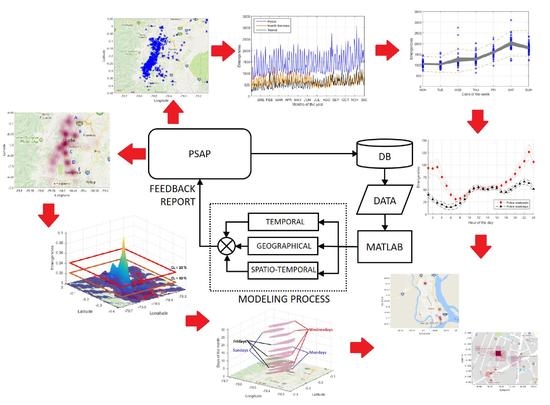Statistical, Spatial and Temporal Mapping of 911 Emergencies in Ecuador
Abstract
:1. Introduction
2. Emergency Representation Model
2.1. Operation of a PSAP at ECU 911
2.2. Temporal Event Analysis
2.3. Geographical Event Analysis
2.3.1. Parzen Windows
2.3.2. Short-Scale Adjustment of the Parzen Width
3. Experiments and Results
3.1. Results of Temporal Analysis
3.2. Geographical and Spatiotemporal Analysis
4. Discussion and Conclusions
Acknowledgments
Author Contributions
Conflicts of Interest
References
- Marshall, R.; Schulzrinne, H. Requirements for Emergency Context Resolution with Internet Technologies; Securities and Exchange Commission: Washington, DC, USA, 2008.
- Swales, S.C.; Maloney, J.E.; Stevenson, J.O. Locating mobile phones and the US wireless E-911 mandate. In Proceedings of the Novel Methods of Location and Tracking of Cellular Mobiles and Their System Applications, London, UK, 17 May 1999; pp. 2/1–2/6. [Google Scholar]
- Reed, J.H.; Krizman, K.J.; Woerner, B.D.; Rappaport, T.S. An Overview of the Challenges and Progress in Meeting the E-911. IEEE Commun. Mag. 1998, 36, 30–37. [Google Scholar] [CrossRef]
- Seeman, E.; Holloway, J.E. Next generation 911: when technology drives public policy. Int. J. Bus. Contin. Risk Manag. 2013, 4, 23–35. [Google Scholar] [CrossRef]
- Schabenberger, O.; Gotway, C.A. Statistical Methods for Spatial Data Analysis; CRC Press: Boca Raton, FL, USA, 2017; pp. 1–6. [Google Scholar]
- Wan-Jo, B.; Asad-Khan, R.M. An Event Reporting and Early-Warning Safety System Based on the Internet of Things for Underground Coal Mines: A Case Study. Appl. Sci. 2017, 7, 925. [Google Scholar] [CrossRef]
- Segura-García, J.; Pérez-Solano, J.J.; Cobos-Serrano, M.; Navarro-Camba, E.A.; Felici-Castell, S.; Soriano-Asensi, A.; Montes-Suay, F. Spatial Statistical Analysis of Urban Noise Data from a WASN Gathered by an IoT System: Application to a Small City. Appl. Sci. 2016, 6, 380. [Google Scholar] [CrossRef]
- Hong, Y.; Bonhomme, C.; Soheilian, B.; Chebbo, G. Effects of Using Different Sources of Remote Sensing and Geographic Information System Data on Urban Stormwater 2D–1D Modeling. Appl. Sci. 2017, 7, 904. [Google Scholar] [CrossRef]
- Jennex, M.E. Modeling emergency response systems. In Proceedings of the 40th Annual Hawaii International Conference on System Sciences, Waikoloa, HI, USA, 3–6 January 2007; Available online: http://ieeexplore.ieee.org/abstract/document/4076412/authors (accessed on 29 January 2018).
- ECU911. Estadisticas. Available online: http://www.ecu911.gob.ec/estadisticas/ (accessed on 28 July 2017).
- Hassani, S. Mathematical Methods: For Students of Physics and Related Fields; Springer Science & Business Media: New York, NY, USA, 2008; Volume 720. [Google Scholar]
- Efron, B.; Tibshirani, R.J. An Introduction to the Bootstrap; CRC Press: Boca Raton, FL, USA, 1994. [Google Scholar]
- Alonso-Atienza, F.; Rojo-Álvarez, J.L.; Rosado-Muñoz, A.; Vinagre, J.J.; García-Alberola, A.; Camps-Valls, G. Feature selection using support vector machines and bootstrap methods for ventricular fibrillation detection. Expert Syst. Appl. 2012, 39, 1956–1967. [Google Scholar] [CrossRef]
- Parzen, E. On estimation of a probability density function and mode. Ann. Math. Statist. 1962, 33, 1065–1076. [Google Scholar] [CrossRef]
- Yeung, D.Y.; Chow, C. Parzen-window network intrusion detectors. In Proceedings of the 16th International Conference on Pattern Recognition, Quebec, QC, Canada, 11–15 August 2002; Volume 4, pp. 385–388. [Google Scholar]
- Figuera, C.; Mora-Jimenez, I.; Guerrero-Curieses, A.; Rojo-Alvarez, J.; Everss, E.; Wilby, M.; Ramos-Lopez, J. Nonparametric model comparison and uncertainty evaluation for signal strength indoor location. IEEE Trans. Mob. Comput. 2009, 8, 1250–1264. [Google Scholar] [CrossRef]
- Botev, Z.I.; Grotowski, J.F.; Kroese, D.P. Kernel density estimation via diffusion. Ann. Stat. 2010, 38, 2916–2957. [Google Scholar] [CrossRef] [Green Version]
- Stoica, P.; Moses, R.L. Spectral Analysis of Signals; Pearson Prentice Hall: Upper Saddle River, NJ, USA, 2005; Volume 452, pp. 25–26. [Google Scholar]
- Martin, J.; Hillen, T. The spotting distribution of wildfires. Appl. Sci. 2016, 6, 177. [Google Scholar] [CrossRef]
- Medina, A.R.; Oterino, B.; Belen, M.; Escribano, G.; Miguel, J.; Cárdenas, P.; Aníbal, H.; Aníbal, H.; Roberto, A.; Santiago, T.; et al. Aceleraciones registradas y calculadas del sismo del 12 de agosto de 2014 en Quito. Ciencia 2014, 16, 139–153. [Google Scholar]
- Walfish, S. A review of statistical outlier methods. Pharm. Technol. 2006, 30, 82. [Google Scholar]
- Correll, M.; Heer, J. Surprise! Bayesian Weighting for De-Biasing Thematic Maps. IEEE Trans. Vis. Comput. Graph. 2017, 23, 651–660. [Google Scholar] [CrossRef] [PubMed]
- Chen, Y.C.; Genovese, C.R.; Wasserman, L. Density Level Sets: Asymptotics, Inference, and Visualization. J. Am. Stati. Assoc. 2017, 1–13. [Google Scholar] [CrossRef]
- Wang, F. Visual Analytics Methods for Exploring Geographically Networked Phenomena. Ph.D Thesis, Arizona State University, Tempe, AZ, USA, 2017. [Google Scholar]
- Spencer, C.; Yakymchuk, C.; Ghaznavi, M. Visualising data distributions with kernel density estimation and reduced chi-squared statistic. Geosci. Front. 2017, 8, 1247–1252. [Google Scholar] [CrossRef]
- Qahtan, A.; Wang, S.; Zhang, X. KDE-Track: An Efficient Dynamic Density Estimator for Data Streams. IEEE Trans. Knowl. Data Eng. 2017, 29, 642–655. [Google Scholar] [CrossRef]
- Li, C.; Baciu, G.; Yu, H. StreamMap: Smooth Dynamic Visualization of High-Density Streaming Points. IEEE Trans. Vis. Comput. Graph. 2017. [Google Scholar] [CrossRef] [PubMed]
- Perrot, A.; Bourqui, R.; Hanusse, N.; Lalanne, F.; Auber, D. Large interactive visualization of density functions on big data infrastructure. In Proceedings of the 2015 IEEE 5th Symposium on Large Data Analysis and Visualization (LDAV), Chicago, IL, USA, 25–26 October 2015; pp. 99–106. [Google Scholar]
- Gan, E.; Bailis, P. Scalable Kernel Density Classification via Threshold-Based Pruning. In Proceedings of the SIGMOD 17 2017 ACM International Conference on Management of Data; ACM: New York, NY, USA, 2017; pp. 945–959. [Google Scholar]
- Zheng, Y.; Ou, Y.; Lex, A.; Phillips, J.M. Visualization of Big Spatial Data using Coresets for Kernel Density Estimates. arXiv, 2017; arXiv:1709.04453. [Google Scholar]
- Chen, W.; Guo, F.; Wang, F.Y. A Survey of Traffic Data Visualization. IEEE Trans. Intell. Transp. Syst. 2015, 16, 2970–2984. [Google Scholar] [CrossRef]
- Shook, E.; Leetaru, K.; Cao, G.; Padmanabhan, A.; Wang, S. Happy or not: Generating topic-based emotional heatmaps for Culturomics using CyberGIS. In Proceedings of the 2012 IEEE 8th International Conference on E-Science, Chicago, IL, USA, 8–12 October 2012; pp. 1–6. [Google Scholar]
- Kucher, K.; Paradis, C.; Kerren, A. The State of the Art in Sentiment Visualization. Comput. Graph. Forum 2017. [Google Scholar] [CrossRef]
- Beigi, G.; Hu, X.; Maciejewski, R.; Liu, H. An Overview of Sentiment Analysis in Social Media and Its Applications in Disaster Relief. In Sentiment Analysis and Ontology Engineering: An Environment of Computational Intelligence; Pedrycz, W., Chen, S.M., Eds.; Springer International Publishing: Cham, Switzerland, 2016; pp. 313–340. [Google Scholar]
- Lu, Y.; Hu, X.; Wang, F.; Kumar, S.; Liu, H.; Maciejewski, R. Visualizing Social Media Sentiment in Disaster Scenarios. In Proceedings of the 24th International Conference on World Wide Web; ACM: New York, NY, USA, 2015; pp. 1211–1215. [Google Scholar]
- Cuenca-Jara, J.; Terroso-Saenz, F.; Valdes-Vela, M.; Skarmeta, A.F. Fuzzy Modelling for Human Dynamics Based on Online Social Networks. Sensors 2017, 17, 1949. [Google Scholar] [CrossRef] [PubMed]
- Google.com. Google Maps API. Available online: https://developers.google.com/maps/documentation/embed/start (accessed on 28 July 2017).
- Snay, R.A.; Soler, T. Modern terrestrial reference systems part 3: WGS 84 and ITRS. Prof. Surv. 2000, 203, 1–3. [Google Scholar]
- Jasso, H.; Fountain, T.; Baru, C.; Hodgkiss, W.; Reich, D.; Warner, K. Spatiotemporal analysis of 9-1-1 call stream data. In Proceedings of the 2006 International Conference on Digital Government Research, San Diego, CA, USA, 21–24 May 2006; pp. 21–22. [Google Scholar]
- Gazquez, J.A.; Garcia, R.M.; Castellano, N.N.; Fernandez-Ros, M.; Perea-Moreno, A.J.; Manzano-Agugliaro, F. Applied Engineering Using Schumann Resonance for Earthquakes Monitoring. Appl. Sci. 2017, 7, 1113. [Google Scholar] [CrossRef]
- Shah, S.A.R.; Brijs, T.; Ahmad, N.; Pirdavani, A.; Shen, Y.; Basheer, M.A. Road Safety Risk Evaluation Using GIS-Based Data Envelopment Analysis—Artificial Neural Networks Approach. Appl. Sci. 2017, 7, 886. [Google Scholar] [CrossRef]
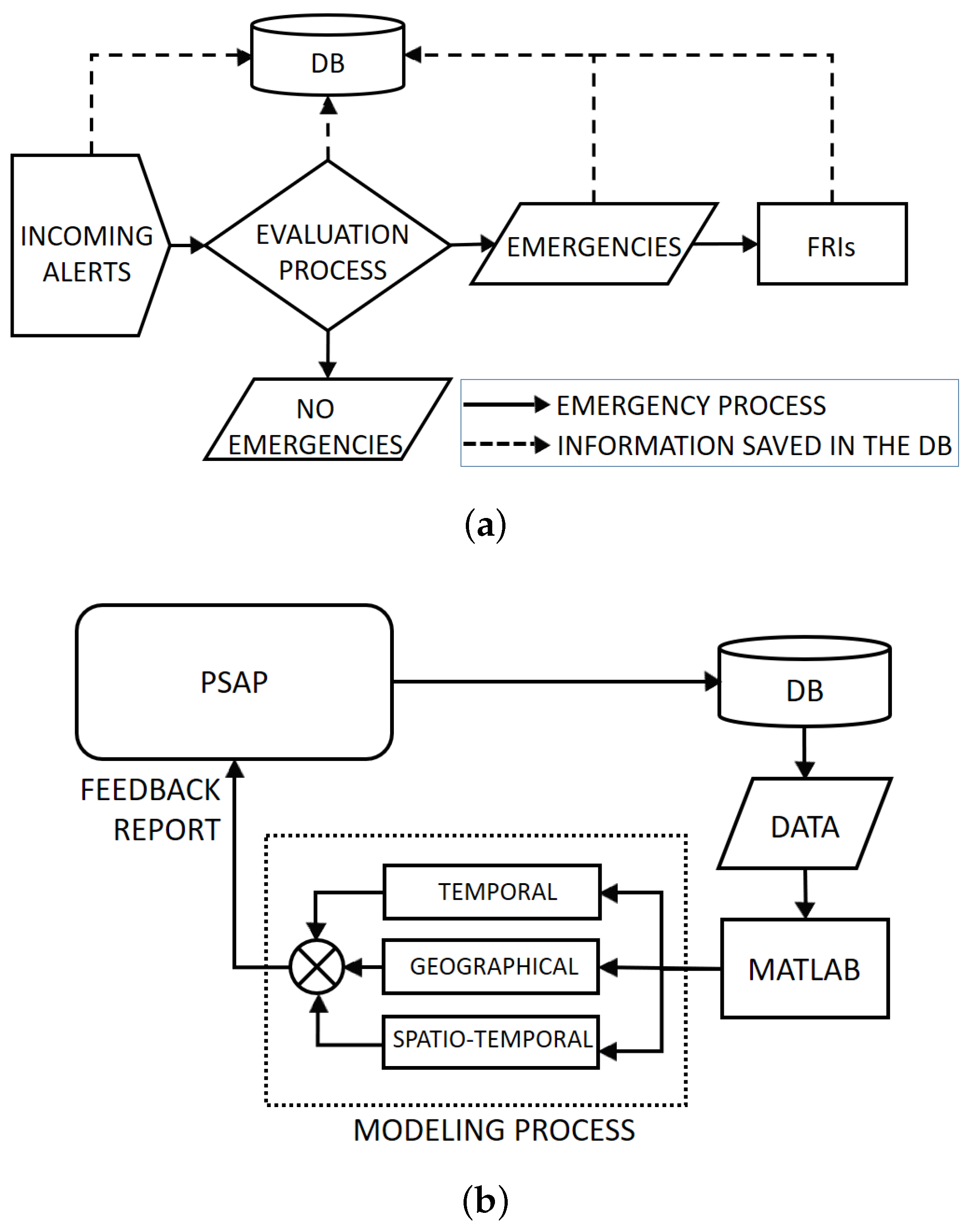

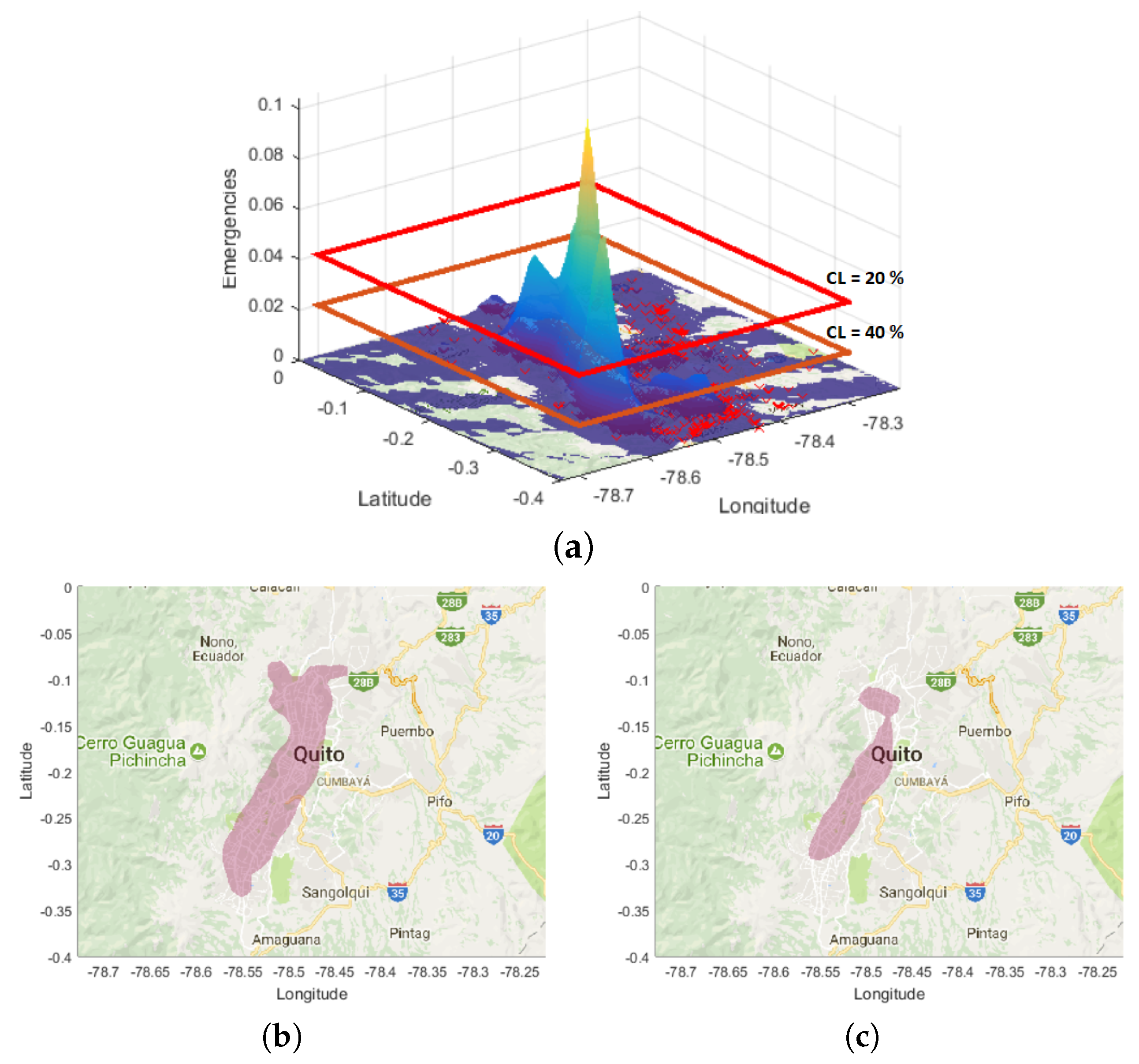
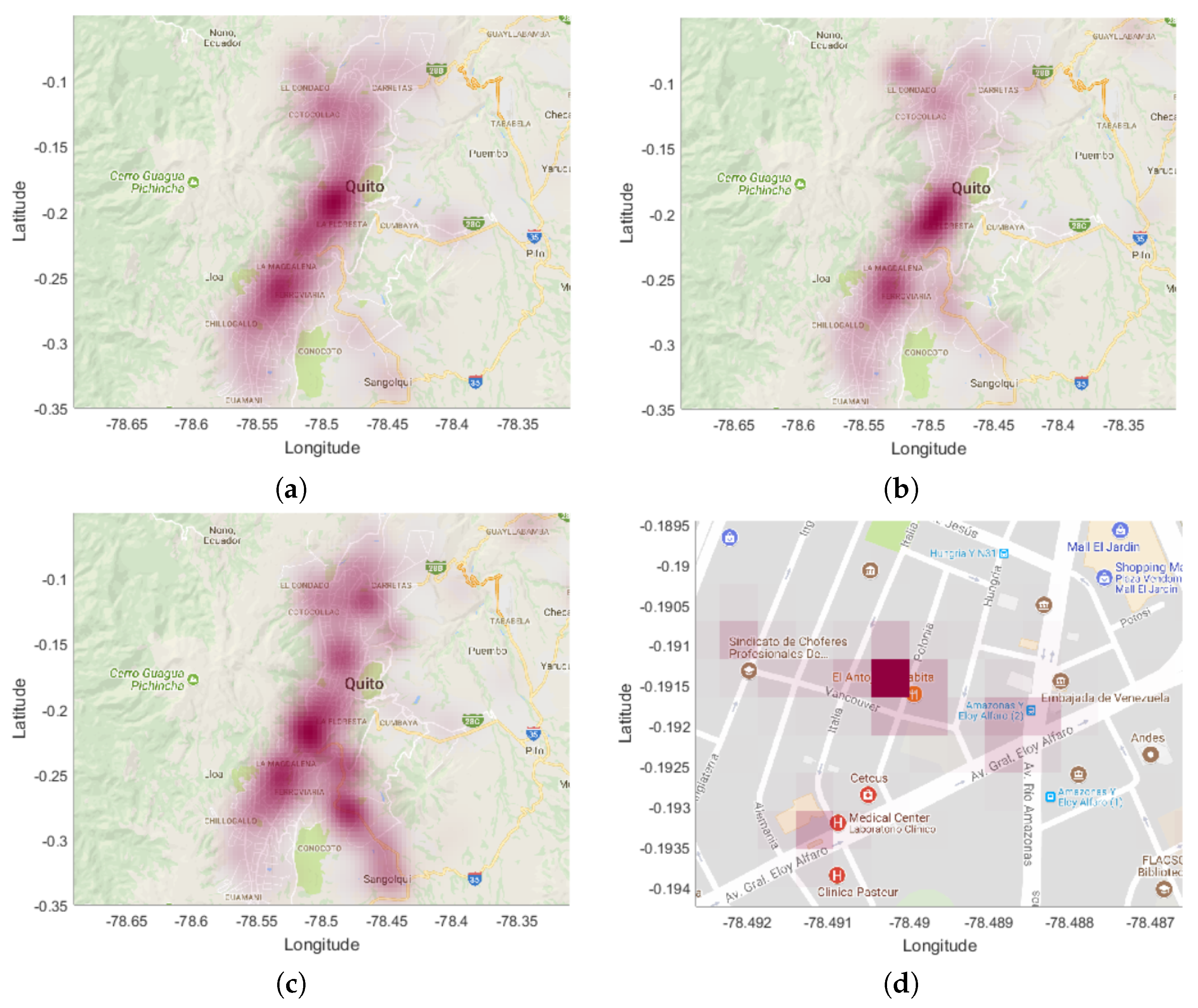

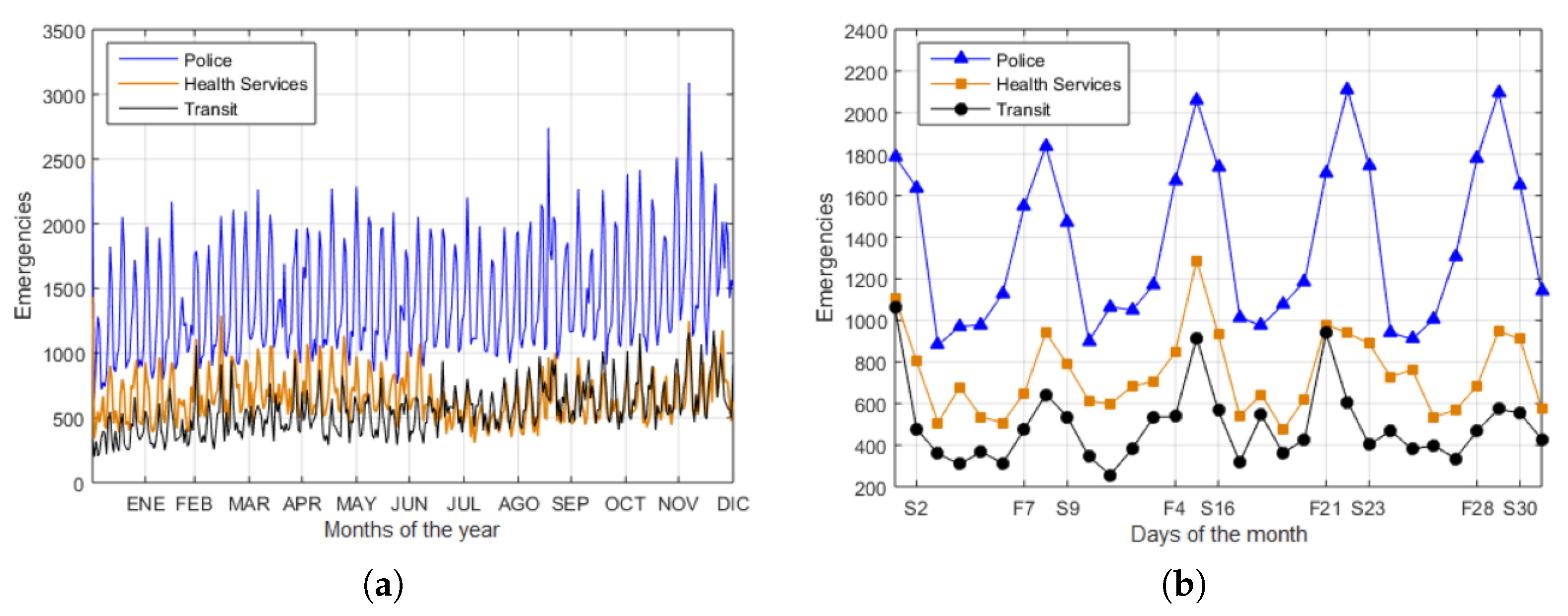
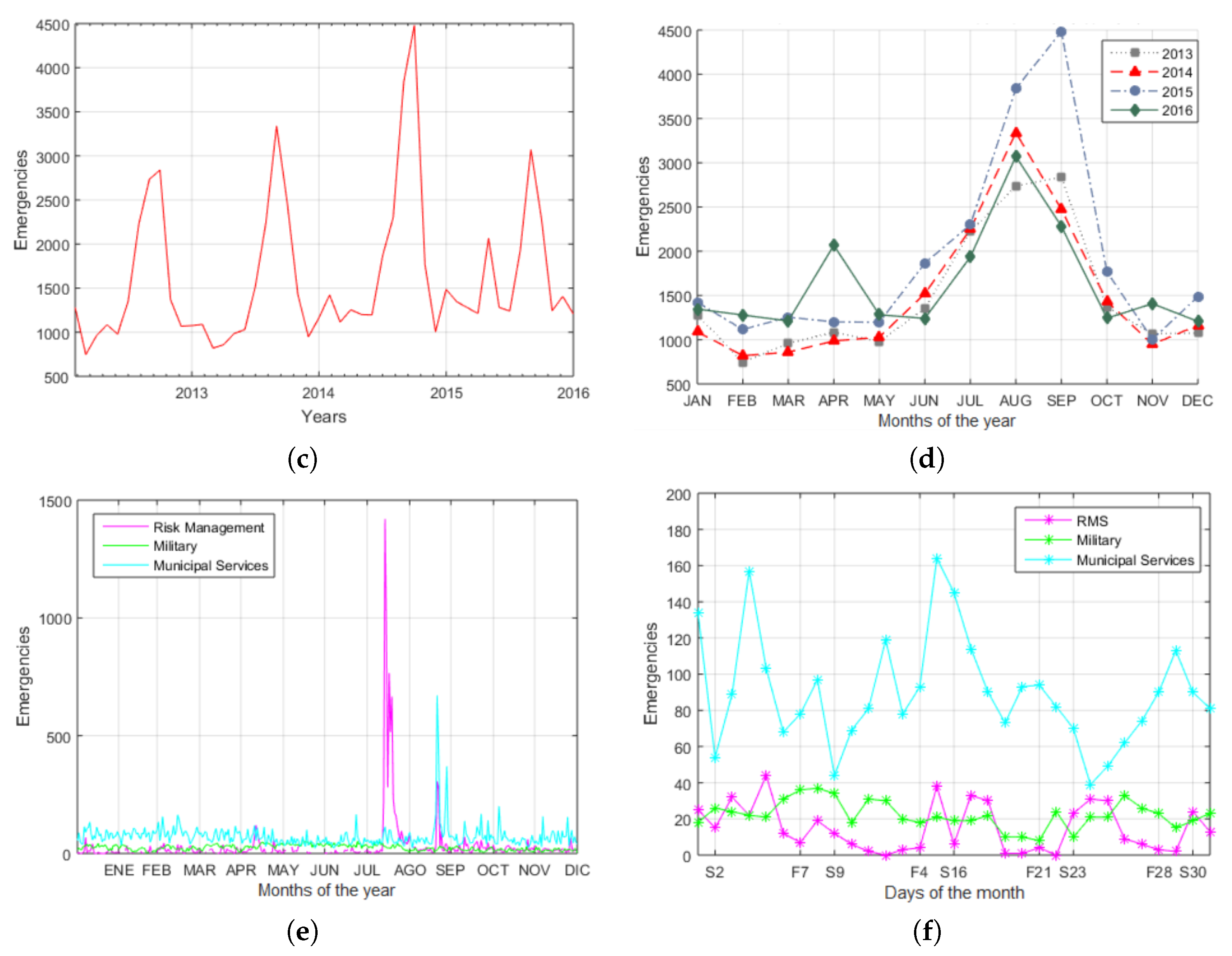
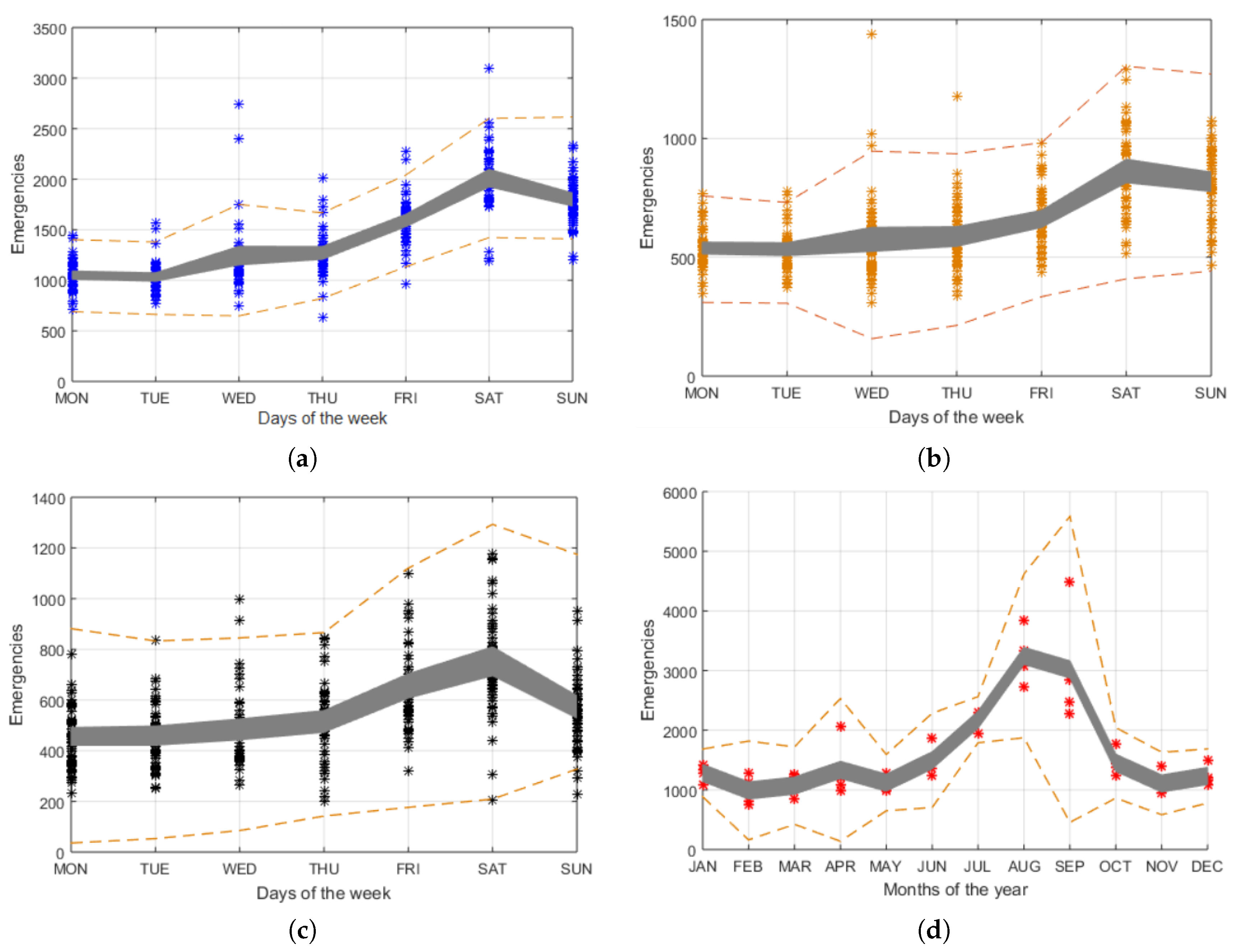
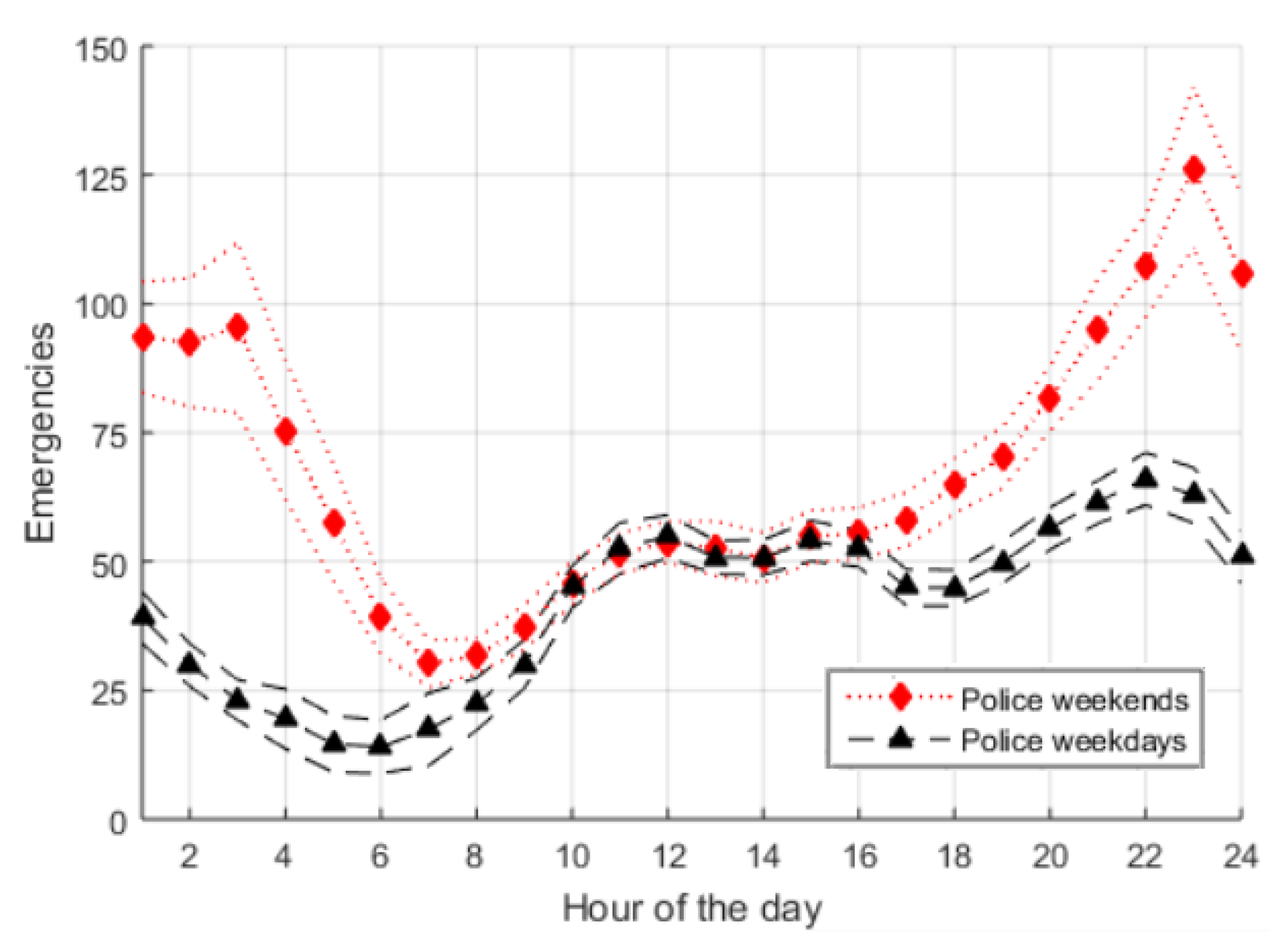
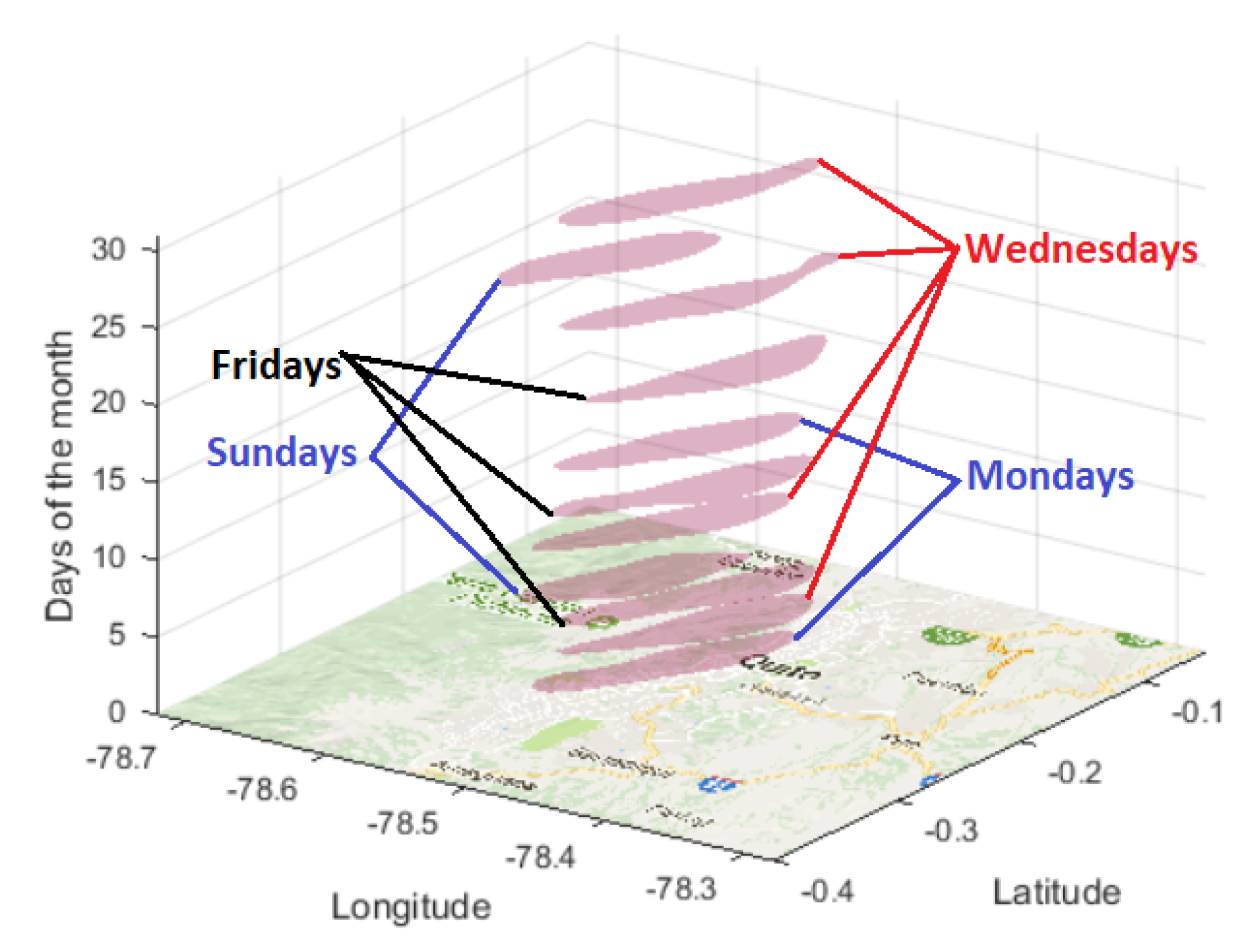
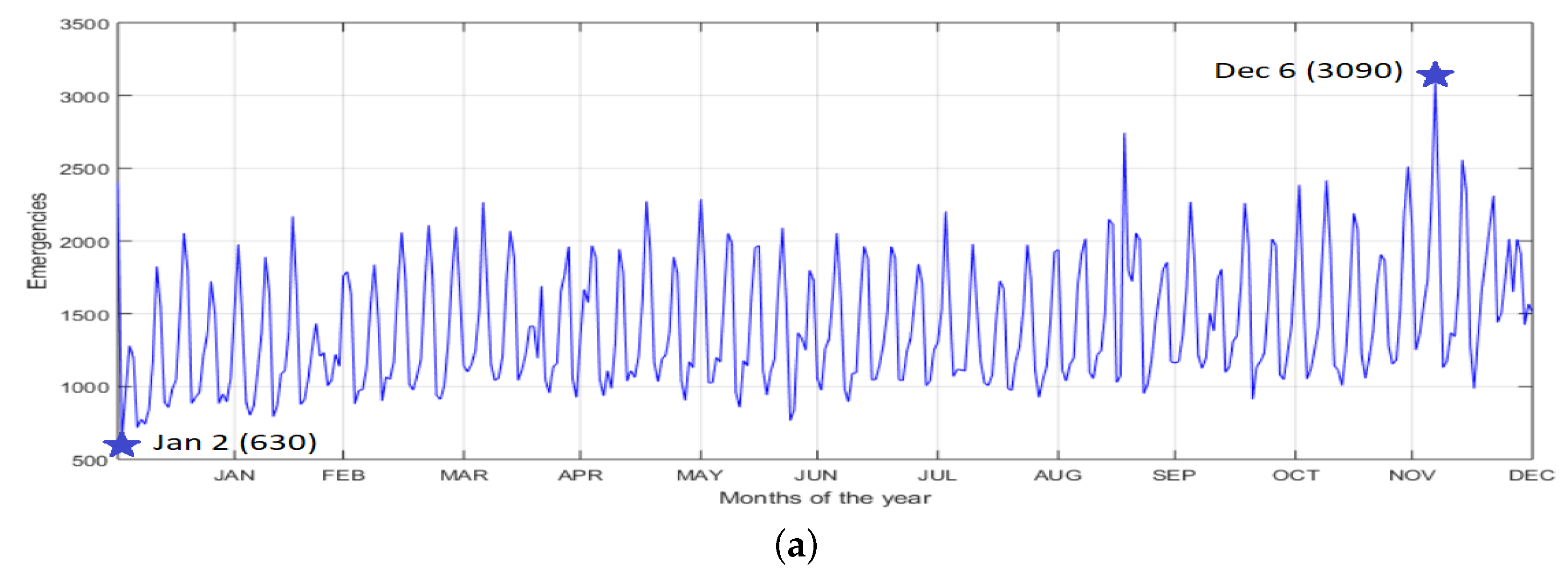
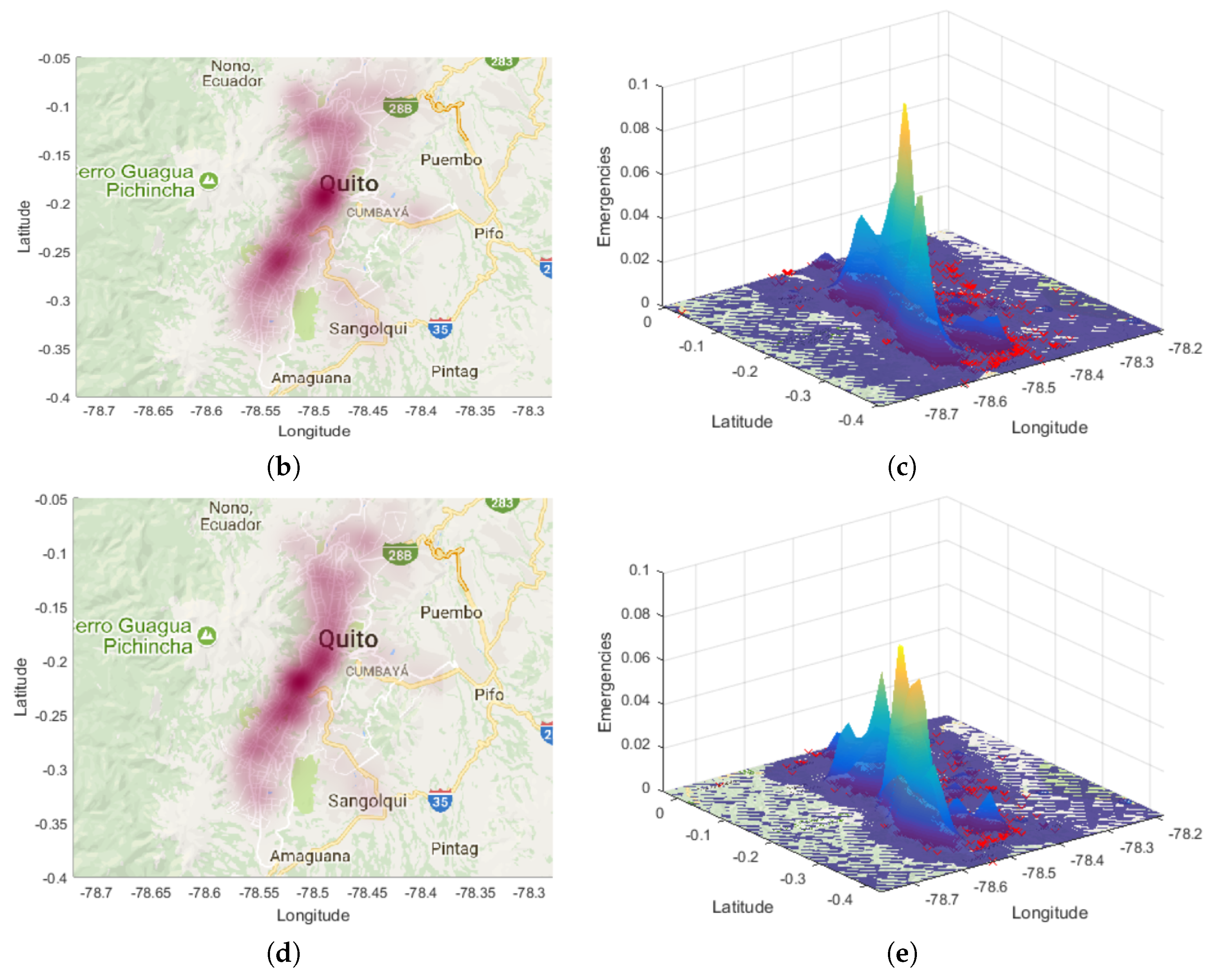
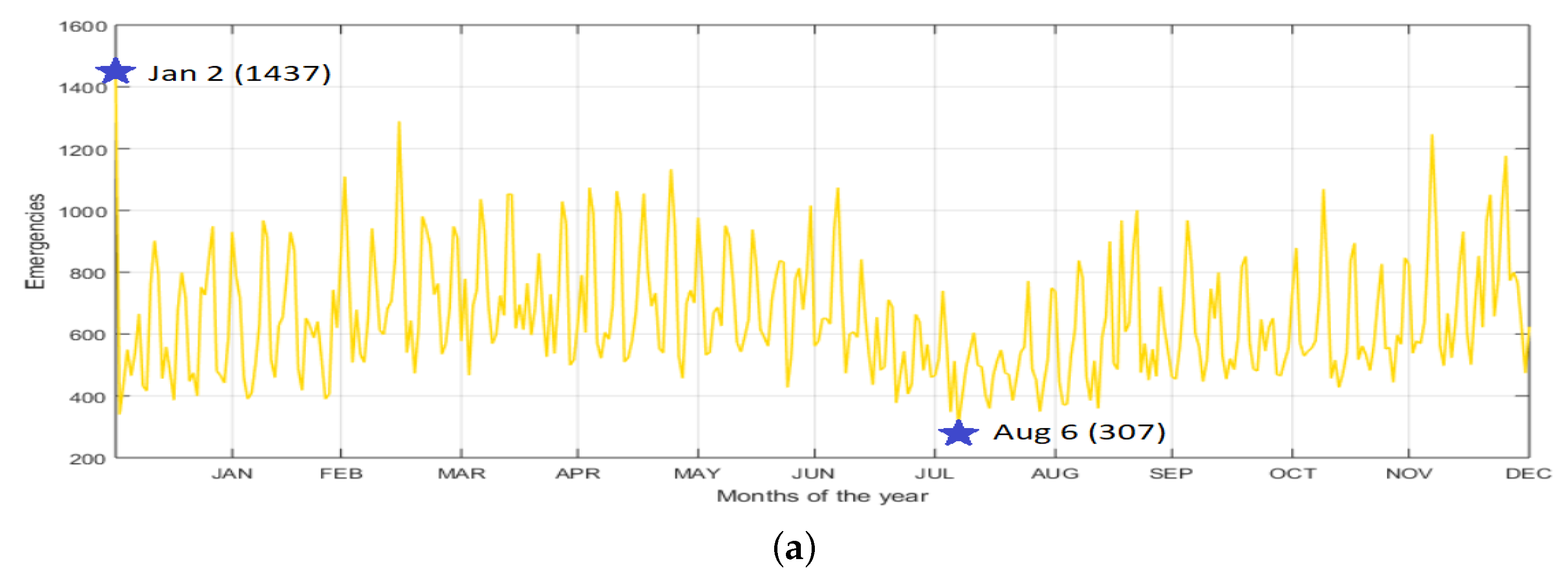
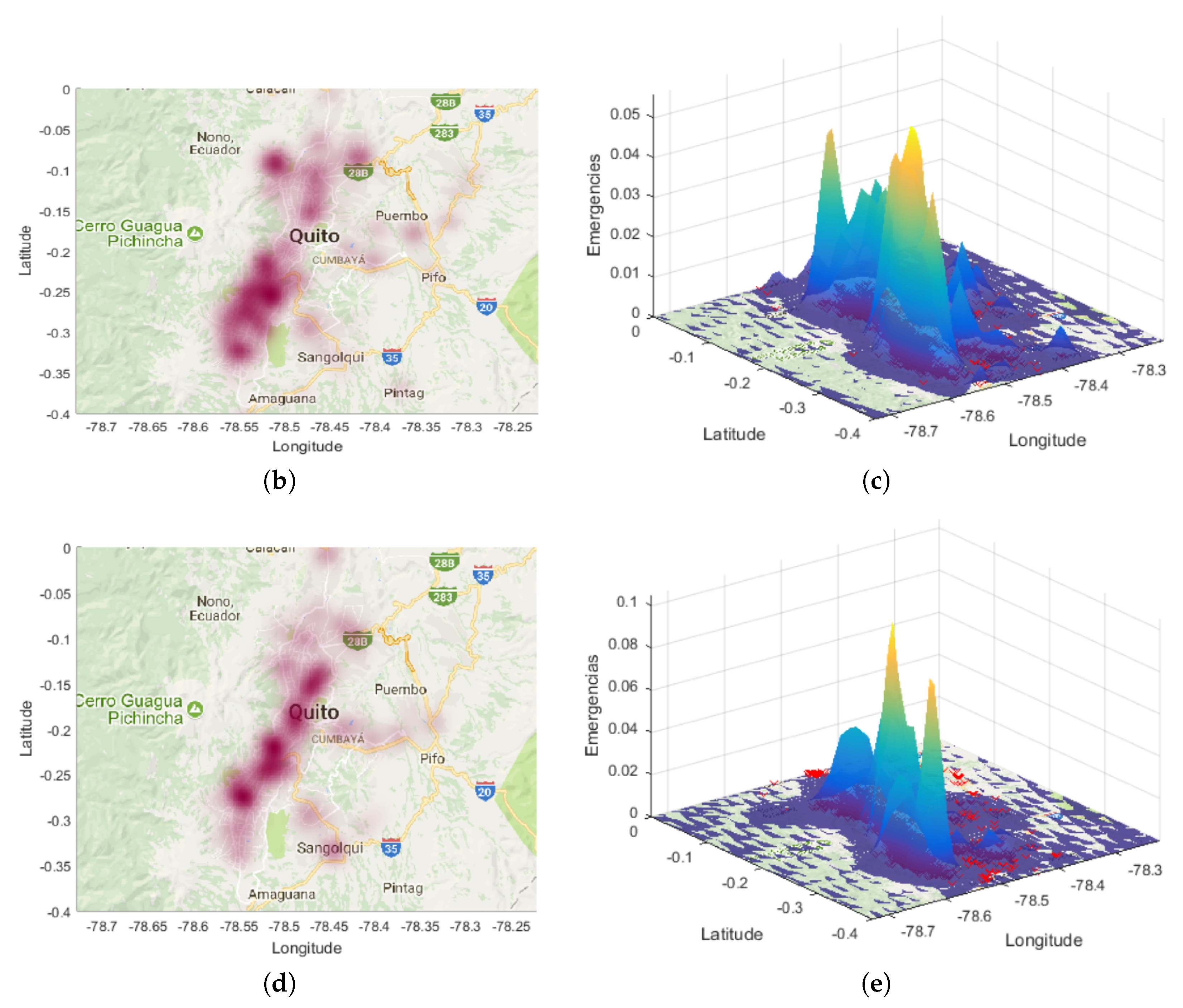
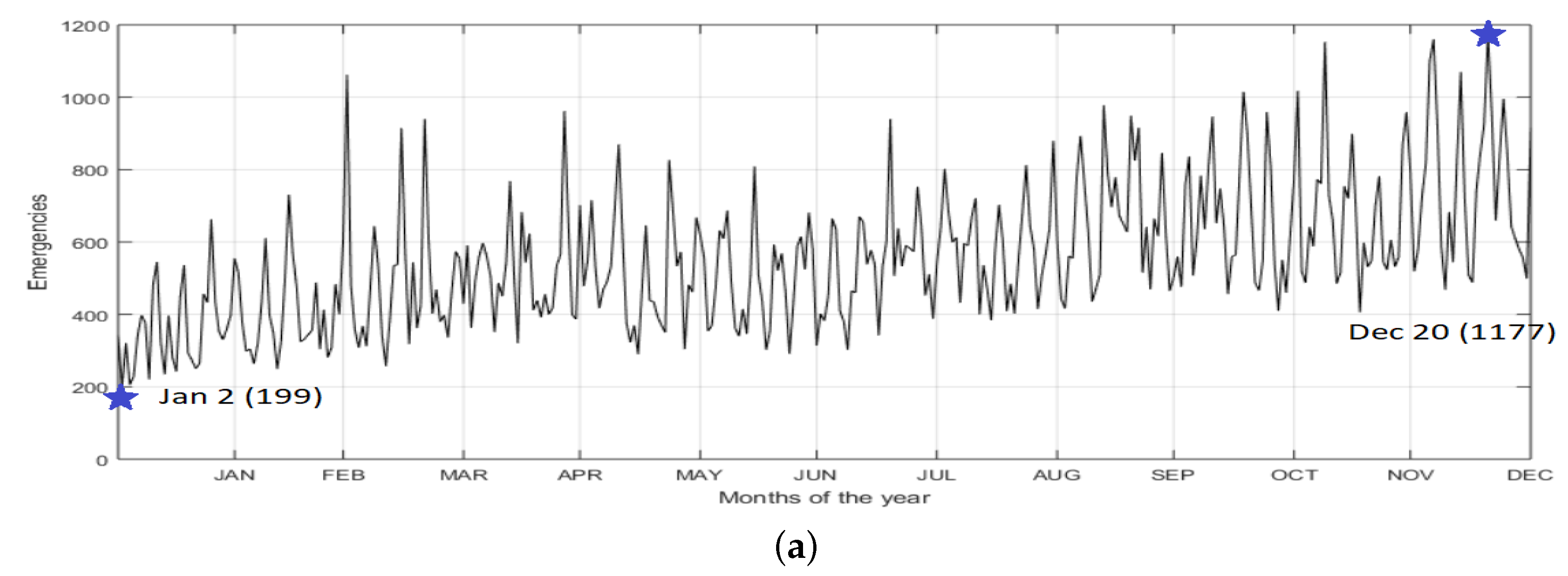
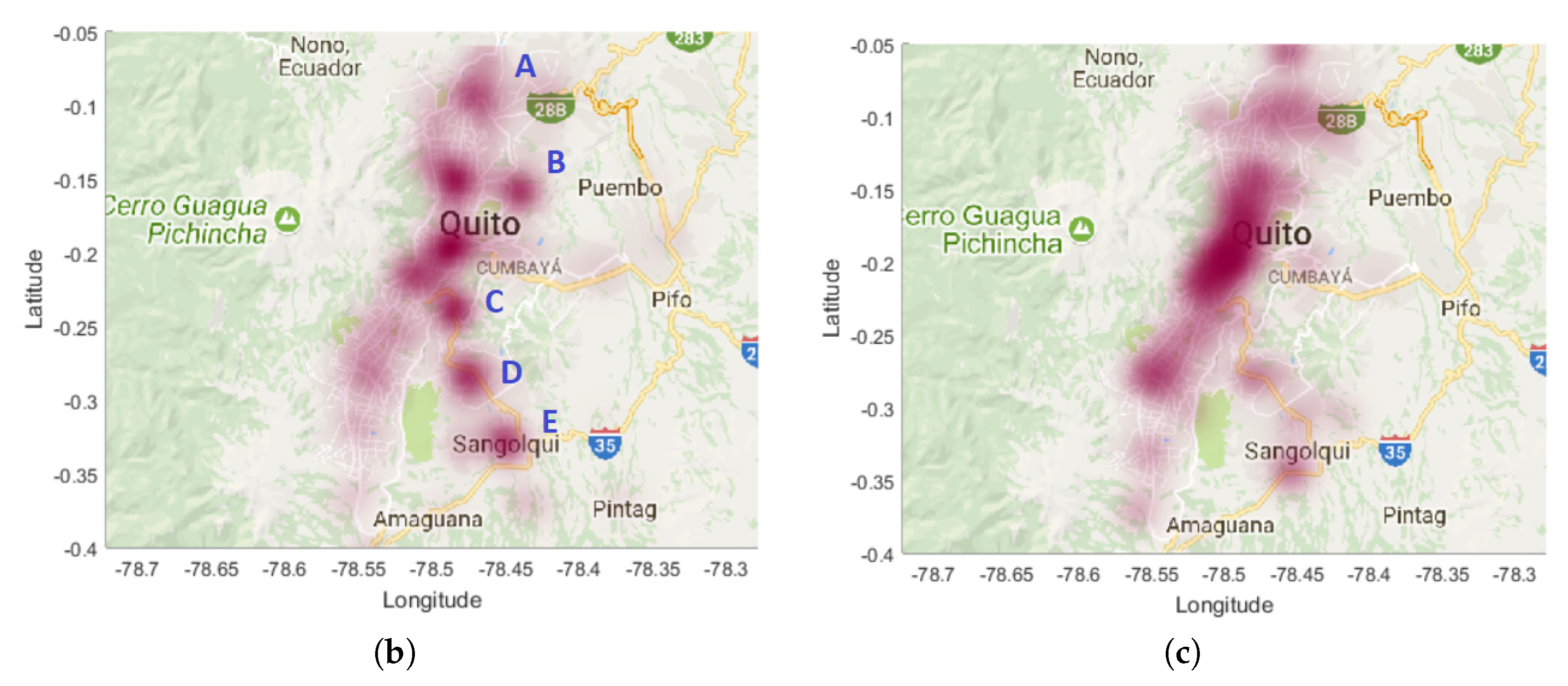
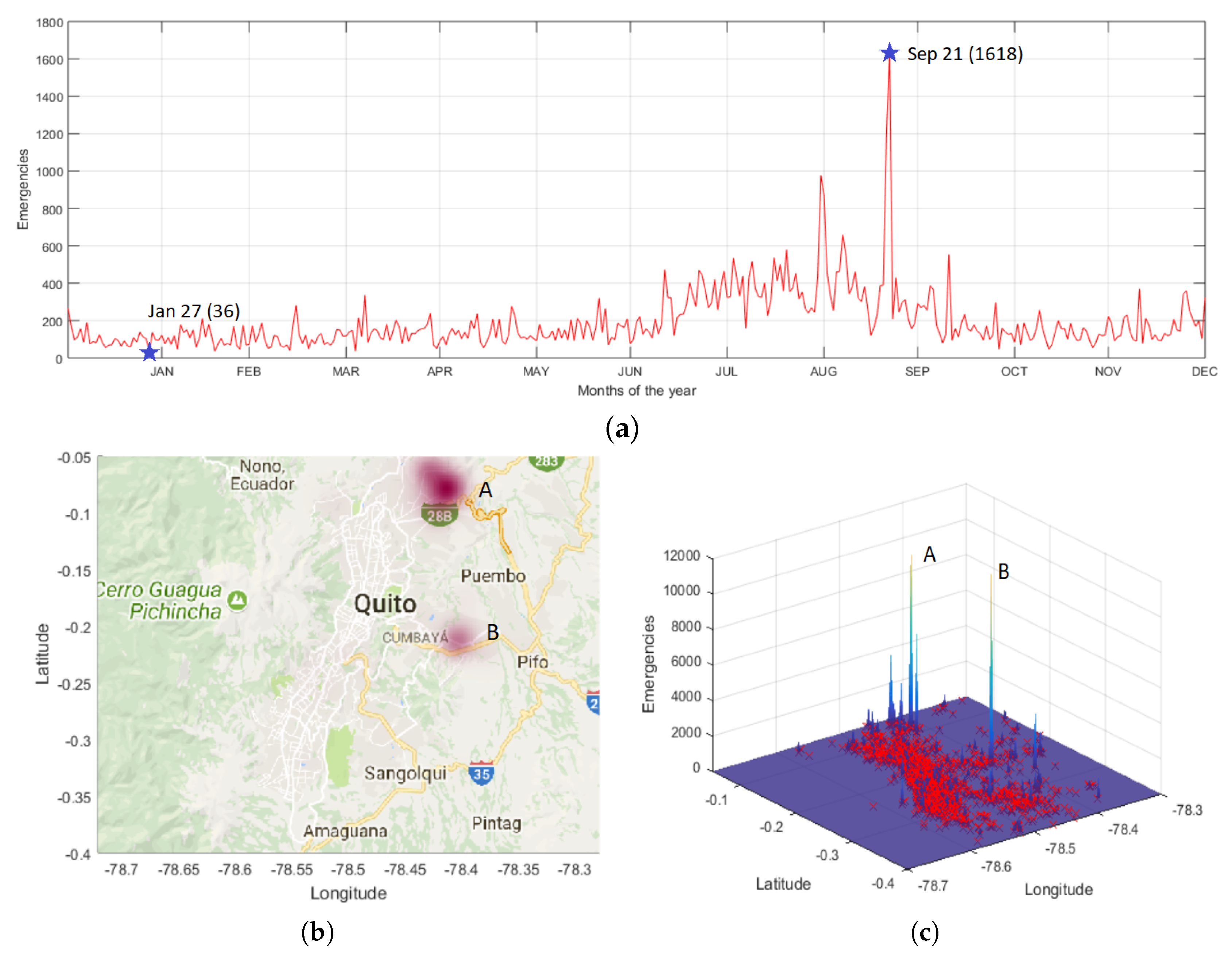
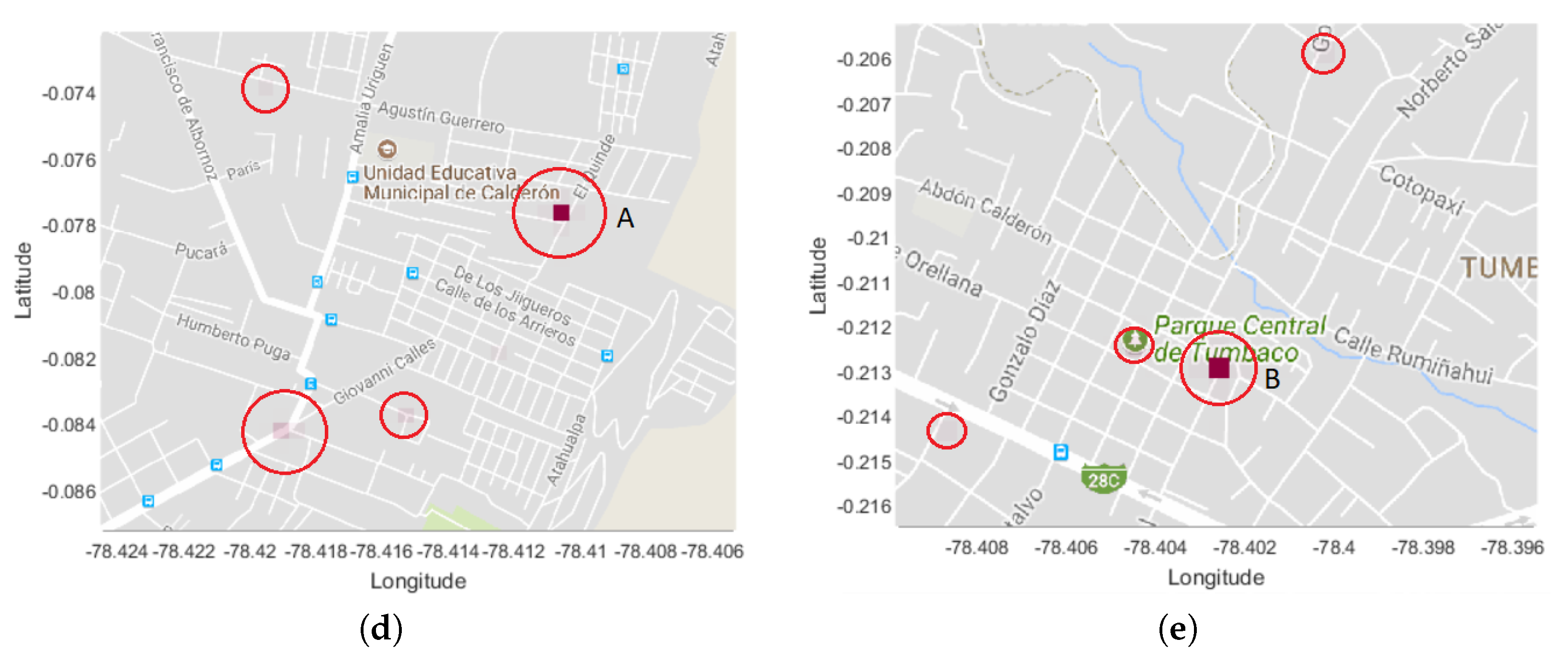

| Institution | Percentage |
|---|---|
| Police | 64.2 |
| Health services | 15.0 |
| Transit | 12.8 |
| Fire brigades | 3.0 |
| Municipal services | 2.8 |
| Military forces | 1.3 |
| Risk management secretaries | 0.9 |
© 2018 by the authors. Licensee MDPI, Basel, Switzerland. This article is an open access article distributed under the terms and conditions of the Creative Commons Attribution (CC BY) license (http://creativecommons.org/licenses/by/4.0/).
Share and Cite
Corral-De-Witt, D.; Carrera, E.V.; Muñoz-Romero, S.; Rojo-Álvarez, J.L. Statistical, Spatial and Temporal Mapping of 911 Emergencies in Ecuador. Appl. Sci. 2018, 8, 199. https://doi.org/10.3390/app8020199
Corral-De-Witt D, Carrera EV, Muñoz-Romero S, Rojo-Álvarez JL. Statistical, Spatial and Temporal Mapping of 911 Emergencies in Ecuador. Applied Sciences. 2018; 8(2):199. https://doi.org/10.3390/app8020199
Chicago/Turabian StyleCorral-De-Witt, Danilo, Enrique V. Carrera, Sergio Muñoz-Romero, and José Luis Rojo-Álvarez. 2018. "Statistical, Spatial and Temporal Mapping of 911 Emergencies in Ecuador" Applied Sciences 8, no. 2: 199. https://doi.org/10.3390/app8020199





